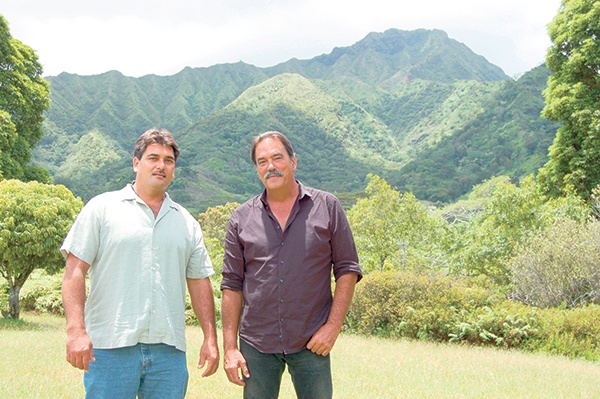KOLOA — Randy Wichman and Canen Ho‘okano have spent most of their lives learning about Kauai. They can tell you, in detail, how the six mokus (districts) on the island have changed over the past 600 years. They can name,
KOLOA — Randy Wichman and Canen Ho‘okano have spent most of their lives learning about Kauai.
They can tell you, in detail, how the six mokus (districts) on the island have changed over the past 600 years.
They can name, by heart, the 54 ahupuaas on Kauai — traditional wedged-shaped land divisions that extended from the mountain to the ocean.
If you were to go out in the field with them, they can even show you where traditional land divisions, outlined in maps dating back to the mid-1800s, began and ended.
But no classes, they said, could teach them what they have learned.
“Over the years, it took a lifetime to understand — you know, growing up, being in the mountains and hunting — how everything works,” Ho‘okano said.
And, together, they and nearly a dozen volunteers from Na Hoku Welo are seeking to reawaken those cultural practices and add in a few new modern twists to bring these traditions into the 21st century.
The Lihue nonprofit’s most recognizable project, done in collaboration with the County of Kauai and several state agencies, is Kauai Nui Kuapapa, a cultural and historical project that is seeking to identify, map out and provide a detailed history of the individual mokus and ahupuaas on Kauai.
“Our idea is that it is beyond just culture,” Wichman said. “Yeah, we are a unique island — our heritage is unique and our royal line is unique. So it is to heighten the idea that all of us truly live in the most unique place in the world and to preserve what makes us unique. It gives the community a sense of pride and it gives the island a sense of direction — it makes a better place for us all to live.”
Wichman, a cultural historian, and Ho‘okano, a cultural and land specialist, said their efforts and research began nearly two years ago, when county officials were crafting plans for a stewardship agreement at Kaneiolouma Heiau in Poipu.
From there, the project snowballed into an ethnographic survey of Kauai that traced the island’s history back to Manokalanipo, the alii aimoku (high chief) of the island during the 15th century.
That period of time, Wichman said, is considered to be “the golden age of Kauai,” when agriculture prospered, the island’s government was restructured, and the mokus and ahupuaas were created.
Though the six moku on Kauai predominantly remained intact over the years since then, the number of ahupuaas on the island fluctuated over time as population shifts occurred.
But they didn’t just rely on Hawaiian newspapers and other scholarly works for their research.
A lot of feedback, Ho‘okano said, was also collected from community leaders, who knew the oral histories of their districts through meles (chants).
“In each one of the communities that we went into, the elders were there, and that was exciting,” Wichman said. “They understood right away what the ancient borders meant from memories from their grandparents and their grandparents.”
The group’s first milestone took place in May, when six signs, delineating the boundaries of the six moku on Kauai, were unveiled.
The next step, Wichman said, is creating signs for each of the 54 ahupuaa on the island, compiling historical information on the Kauai Nui Kuapapa website for the public to freely access and developing a smartphone application using geographic information systems (GIS) data as a visual reference for the group’s research.
The Garden Island sat down with Wichman and Ho‘okano earlier this week at Kahili Mountain Park, where they shared their insights on the group’s efforts.
TGI: Why is and was it so important for people to know the moku and ahupuaa that they lived in?
Wichman: Both Canen and I, even as babies, understood the importance of place names because it gave us the land use, the history and people. We always found it interesting and have been pursuing it for these years.
Ho‘okano: They’re all named for specific purposes and for real reasons like agriculture — there were differences between certain areas.
Wichman: I think, within all of us, the most important thing is that in the way we describe where we live is a classically Hawaiian sense of the description of the land and ocean. It’s important that you understand the district you live in because that gives you the general borders of your boundaries — your areas of responsibility. For example, I’m from the moku of Halelea, my ahupuaa is Haena, my mountain is Pohaku-o-kane and Makana and my chief is Lohiau. You know, Hawaiians never spoke for everyone, in a way — maybe the moi (king), but nobody else speaks for everybody. You do have an area of responsibility within your district and your ahupuaa, and I think that kind of defines to the human psyche, ‘If I’m going to make a difference, I need to begin in my own front yard, so where is my front yard? It’s my moku, it’s my ahupuaa.’
Ho‘okano: It boils down to our identity and who we are, and collaboratively, how productive we can make our ahupuaa that we come from and our moku as a whole — building communities, having people work together, teaching the children and learning from the kupuna within the old, traditional ways.
Wichman: For us, it’s exciting. Now, when you go into public meetings, you’re going to hear people say, ‘I’m from this moku, my ahupuaa is this.’ And we’ve heard it immediately and that’s why we love this island — it’s not too big and it’s not too small. The change of mindset here is pretty cool because the news travels.


